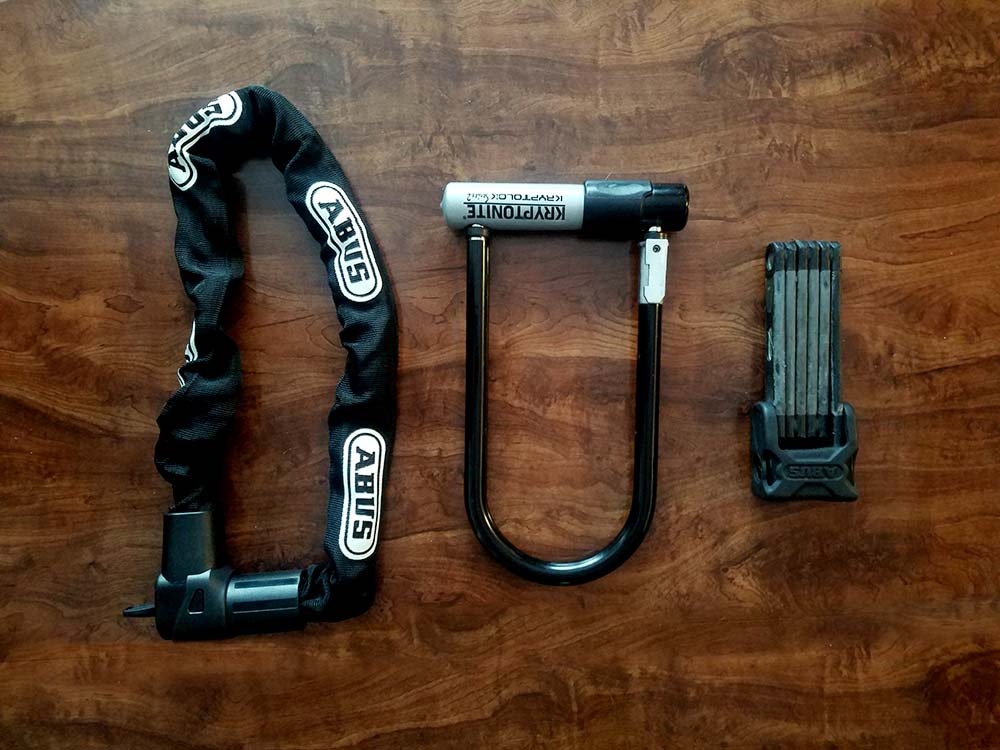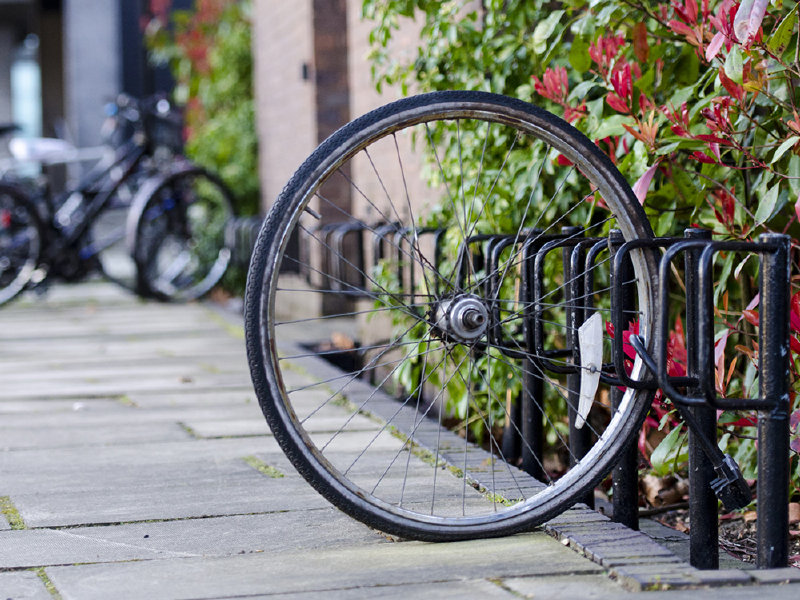Back in 2018 WISN reported that the police had found a stash of stolen bikes and were hoping to reunite some of them with their owners. But the unfortunate thing about resolving bike theft is that it's much easier to recover and reunite property if steps are taken BEFORE the theft happens. And even when you try to protect yourself as much as you can, the reality is most stolen bikes will not find their way back home.
People get emotionally attached to their bicycles. Cycling is an activity that swirls together a variety of emotions, from struggles to successes. It's a freedom machine that is personalized to your body type, that you touch, pedal, push and stick between intimate places. When you find the right bike, it's something that's painful to lose.
So your best interest in protecting your beloved bicycle is to decrease the odds of theft first, then increase the odds of recovery and minimize the loss second by following these steps.
What to do BEFORE your bike is stolen:
Make sure you've got a record of ownership.
1) Write down your serial number
This is the most important step. The bike's serial number is a unique identifier that is hard to spoof and hard to remove, and it is the strongest key to getting your bike back. Milwaukee Police Department Officer Robert Matheus noted that they recover hundreds of bikes a year, and very few, if any, have a police report with a serial number attached.

Officers can't return your bike to you if you don't have this kind of proof. Officer Matheus emphasized this point over and over during our brief discussion. Make sure you record your serial number and keep it in a safe place.

2) Take well-lit pictures of your bike
It's hard to rally the masses to keep an eye out for your bike when they don't know what it looks like. Take a couple of proper photos of your bike. This will help your friends, local shops and authorities understand what they are looking for.
"If we see something that looks familiar, we can stop people for probable cause and ask them about their bike," says Matheus. "Sometimes they'll say they found it, or they bought it from someone else. In either case, we can recover the bike."
But a photo is not enough for officers to return your bike, no matter how unique it is. This is why the serial number is so important.
"If there is no registration or serial number that matches the bike, it will be difficult to return the bike to its owner," Matheus said.
Make sure you update your photo file when you change components (such as a new color of bar tape, or a new saddle) or add stickers. The more unique your bike looks, the easier it will be to spot.
3) Register your bike
You can obtain a bike license from any public library (which are currently closed due to COVID-19) or Milwaukee District station and then activate it online for free. The license will help authorities reconnect you with your bike via the license number, your personal contact information and, you guessed it, the bicycle's serial number.
These licenses are unfortunately big and ugly, and aesthetically unworthy of your noble steed. I asked Matheus if you could just cut out the license number (the important part) and affix that to the underside of your bike.
"Unfortunately, most officers probably wouldn't know what they were looking at," Matheus said. "But you can still register your bike without putting the license on it. The database will have your contact information with the serial number, and that's the most important part." (See, he said it again!)


4) Get renter's insurance (because you probably won't get your bike back)
"Recovering stolen bikes is a low priority for officers, especially in busier districts dealing with drugs and guns," Matheus said. If your bike is stolen, it is unlikely you'll get it back, so homeowner's and renter's insurance insurance provide a nice safety net.
You'll have to check with your agent, but plans will cover the cost of a new bike, minus your deductible. So, if you have a habit of spending less than $200 on a bike, this may not be of much help.
Many plans will cover the replacement cost of a comparable new bike, rather than the depreciated value of the bike (the garage sale price) and often they will cover it no matter where it was stolen – whether inside or outside your apartment, down the street or across the country.
How to prevent your bike from being stolen:
You can do these two things daily to fight against bike theft. These steps do not guarantee the safety of your bicycle, but the less vulnerable your bike is, the more likely that thieves will look at easier prey.
1) Always lock your bike when you're in public places
Bikes are usually stolen for two reasons: they weren't locked up, or they weren't locked to something solid. It cannot be overstated that you must always lock up your bike whenever you are out in public.

If you're going into a store for 2 seconds, lock your bike. If you're waiting at a checkpoint during the Riverwest 24, lock your bike. Even if you are having a drink at a Beer Garden and your bike is within eyesight, lock up your bike.
You may be fast, but a bike thief on your bike is faster.
Here's a helpful rhyming mnemonic to remind you of when you should lock your bike:
Always
Lock up
While
Away or
You'll be
Sorry one day
Secure, underground parking and shared apartment basements — even with friends — also count as public places. Lock up securely here, too.
The city has also provided a guide illustrating the best locking methods.
2) Don't leave it outside very long, if you can help it

Outside is a great place to ride a bike, but outside is not a great place to store a bike. Bikes that are viewed as untouched or abandoned are prone to disappearing (either the whole bike or components, such as lights, seats, and wheels). Bring it inside whenever you can to avoid hungry eyes. And, as a bonus, you'll be protecting it from the elements, so it'll also require fewer tune-ups.
Some apartments are small, and some bikes are difficult to carry up stairs, but it's worth the sacrifice.
As for garages, keep the doors closed when you're not in them, and even so, consider locking your bikes in there anyway.
3) Do GPS tracking devices work?
GPS devices that fit under or inside bikes may provide some peace of mind, but they aren't always helpful. Their accuracy — or lack thereof as Matheus suggested — leaves room for reasonable doubt and the fuzzy legality has resulted in a lot of debate, especially regarding police entering private property in search of stolen goods.
If you were to rely on a GPS, you would likely need to track the device on the road and coordinate with the police from there, which is not a particularly easy or safe thing to do.
What to do AFTER your bike is stolen:
Now that you've taken steps to secure and recover your bike, here is what you can do when it does go missing.
1) File a police report
Most stations will take reports over the phone. Call (414) 933-4444 and provide a serial number, description of the bike and your license number. If you don't have all of this information, you should still report your bike stolen, but the more information you have, the better.
2) Post in the stolen bike listings
The Wisconsin Bike Fed helps maintain a listing of stolen bikes. Click the small link to the left to add your bike. Add your serial number, photos of the bike, and other relevant information.
There is also a national registry, so it wouldn't hurt to post there, too. Sometimes thieves move bikes to other markets to protect themselves.
3) Alert the shops
Send a flier to all the shops in the area, include the police report number, serial number and link to your stolen bike listing. If someone tries to sell a suspicious bike, the shops will be armed with all relevant information to secure the bike and take action.
4) Scour the online marketplaces
Pay attention online marketplaces like Craigslist and Facebook Marketplace and keep an eye out for matching entries. If you find a bike that matches your description, do not attempt to re-acquire the bike through trickery, as this could be highly dangerous. Either pay the asking price (a hard pill to swallow, but truly the easiest, safest way to recover your bike) or work with police to retrieve your stolen goods.
It is unlikely the police will accompany you to retrieve your bike, unless you have enough corroborating information. "We can't go into someone's house without a warrant," says Matheus, "otherwise we would be violating people's rights."
Write down your serial number. Always lock your bike. Bring it inside when you're home. With any luck, following these steps will help protect and recover your property, but keep in mind most people aren't so lucky.
Jason McDowell grew up in central Iowa and moved to Milwaukee in 2000 to attend the Milwaukee Institute of Art and Design.
In 2006 he began working with OnMilwaukee as an advertising designer, but has since taken on a variety of rolls as the Creative Director, tackling all kinds of design problems, from digital to print, advertising to branding, icons to programming.
In 2016 he picked up the 414 Digital Star of the Year award.
Most other times he can be found racing bicycles, playing board games, or petting dogs.







